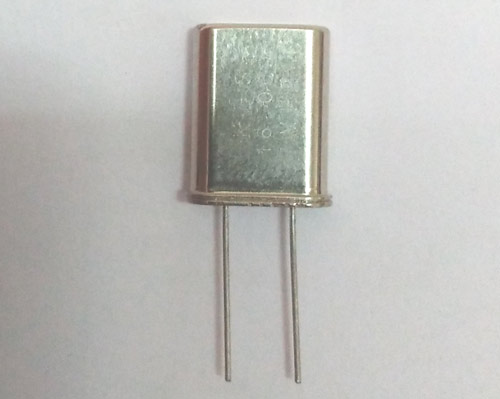Crystal Oscillator
Crystal Oscillators have two leads, there is no polarity for crystals and hence can be connected in both directions.
Features and Specifications
- 18pF of Load Capacitance
- Frequency Tolerance(Ƹf/f) range is ± 30ppm
- Frequency Temperature Stability range is ±50ppm
- Resonance Resistance 40ohms (max)
- Oscillation mode: Fundamental mode
- Shunt Capacitance less than 7pF
- Drive Level less than 100µW
- Operating Temperature Range: -20 to + 70°C
- Operable Temperature Range: -25 to + 85°C
- Storage Temperature Range: -55 to + 125°C
- Insulation Resistance: 500 M ohms
Popular Crystal Oscillators
8MHz, 11.0592MHz, 12MHz, 16MHz, 20MHz, 32MHz
There are many other crystal oscillators available in the market with a different frequency.
Brief about Crystal Oscillator
Crystal Oscillator is an Electronics Oscillator circuit which uses the mechanical resonance of a vibrating crystal of piezoelectric material to generate an electrical signal with an accurate frequency. It also has automatic amplitude control and frequency drift is also very low due to change in temperature. Crystal Oscillators are only suitable for high-frequency application.
Every microcontroller needs a crystal oscillator, whenever selecting a crystal oscillator try to purchase silicon oscillator if the accuracy is adequate and the cost is also acceptable, otherwise choose quartz crystal.
Electrical Equivalents
A crystal oscillator is a piezoelectric device used to convert electrical energy to mechanical energy. The conversion occurs at resonant frequency. The simplified electrical equivalent of crystal oscillator is given below:

Crystal oscillator works on the principle of the Inverse Piezoelectric Effect, the applied electrical field will generate a mechanical distortion across some material. Therefore, it utilizes the vibrating crystal’s mechanical resonance, which is made through a piezoelectric material for generating an electrical signal of a certain frequency.
Series Resonant Frequency
fs=1 / 2π√(L1C1)
Parallel Resonant Frequency
fp=1/ 2π√(C1C2 / C1+C2)
Crystal Oscillator with Micro-controller

The clock source used for microcontrollers are based on mechanical resonant devices such as crystal oscillator. All microcontrollers have particular pins for connecting crystal oscillator. The pins generally named as XTAL1 and XTAL2, here the connection of crystal oscillator with micro-controller is given below:
The reason for using two capacitors in series with crystal oscillator is to resonate with the crystal inductance which cause the crystal to oscillate on its fundamental parallel resonant mode.
There are some factors which affect the frequency stability of an oscillator like variation in temperature, load and supply.
Applications
- Used in frequency synthesizers
- Used in special types of receivers
- Used as crystal clock in microprocessors
- Colpitts Crystal Oscillator Application
- Armstrong Crystal Oscillator
- Military and Aerospace
- Radio and TV transmitters










